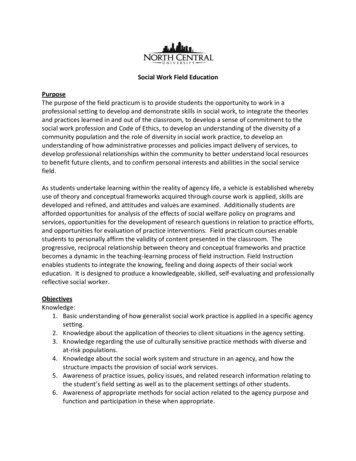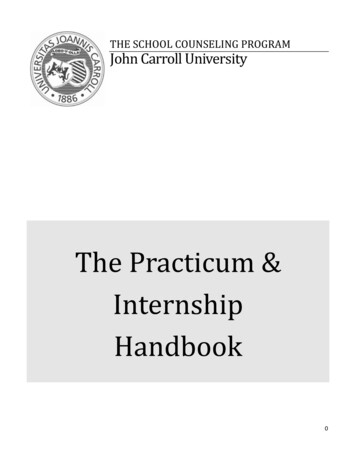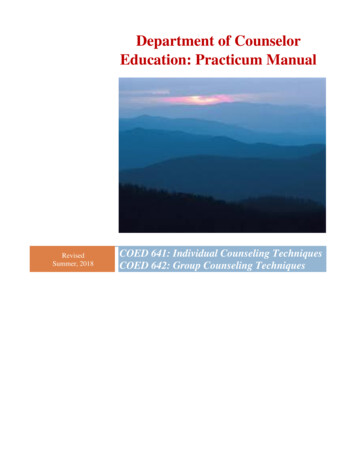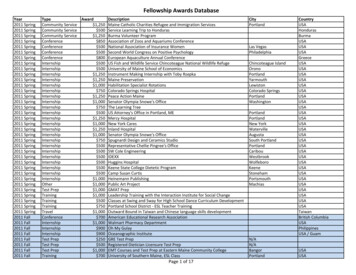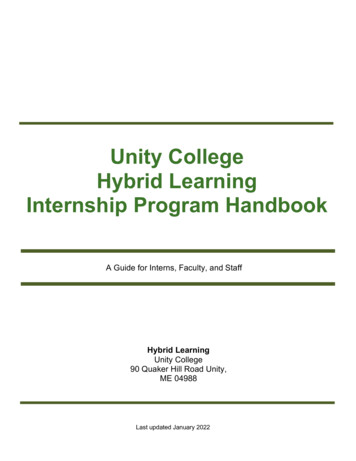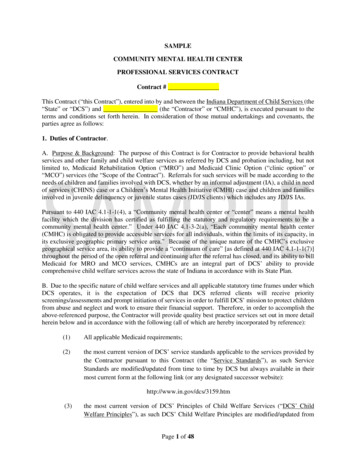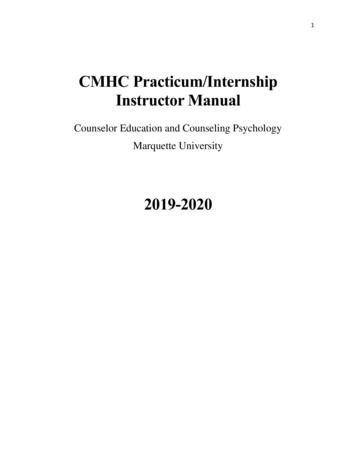
Transcription
1CMHC Practicum/InternshipInstructor ManualCounselor Education and Counseling PsychologyMarquette University2019-2020
2Practicum/Internship Instructor ManualOverview of Practicum/Internship Instructor Manual & FAQs . .3PracticumPracticum Purpose/Description .6Practicum Biweekly Consultation Guidelines and Documentation .9Practicum Documentation—Filing and Records .11Practicum Learning Agreement Guidelines and Rubric .14Practicum Site Visit and Evaluation Schedule .19Course Materials .20Counseling Practicum Syllabus 24InternshipInternship Purpose/Description .39Internship Documentation—Filing and Records 41Internship Site Visit and Evaluation Schedule 44Internship Learning Agreement Guidelines and Rubric .46Course Materials .50Internship in Counseling Syllabus ,,54AppendicesCACREP Standards for Practicum (Curriculum Map)* . .65CACREP Standards for Internship (Curriculum Map)* . .71*Note that standards designated as “X” should be included in the course student learningobjectives. Standards designated as “I” and “A” should be covered somewhere in the course(e.g., in readings, assignments, etc.)
3CMHC Practicum/InternshipInstructor ManualThis manual was developed to provide information for instructors of the Clinical Mental HealthCounseling Practicum (COUN 6965/6968/6966) and Internship in Counseling (COUN6986/6989/6987) courses. Please note that instructors of these courses should be familiar withthe Master’s Student Handbook and the Master’s Practicum and Internship Handbook, the latterof which should be shared with site supervisors.The Practicum and Internship Coordinator (Dr. Jennifer Cook) is responsible for developing andmaintaining CMHC site relationships and student placement. The Practicum and InternshipCoordinator often works with the Director of Counselor Education (Dr. Lisa Edwards) to addresssite and student issues as well as other administrative concerns. The Counseling Practicum andInternship in Counseling instructors are responsible for serving as the primary liaison forstudents and supervisors during the semester.The information provided in this manual includes curriculum and assessment requirements thatpertain to CACREP (2009) accreditation, CECP Program Learning Outcomes, and DSPSlicensure requirements. Please direct any questions about these to Dr. Lisa Edwards(lisa.edwards@mu.edu). If you have any suggestions or ideas for information that should beincluded in the manual please also contact Lisa Edwards.Practicum/Internship FAQsOften students have questions regarding Practicum and Internship requirements. Below are someof these frequently asked questions:What are the hours requirements for Practicum and Internship?Practicum: 100 clock hours over a minimum of 10-week academic term. At least 40 of thesemust be direct hours, and the remainder should be indirect.Internship: 600 clock hours (300 per semester), at least 240 (120 per semester) which are directhours. The remainder should be indirect hours.Per accreditation and department requirements, students must complete all of the required hours.Please see pages 6 and 40 (or the Master’s Practicum and Internship Handbook) for more detailsabout hours requirements.
4Does class time count for indirect hours?This has been confusing for students and faculty in the past. Beginning in Fall 2018, all classtime (including time other than the required 1.5 hours of group supervision) can be logged asindirect hours (group supervision). Please keep in mind that this indirect time should beconnected to students’ client work.What if a student doesn’t complete her/his/their hours before the end of the semester?This is a common situation and is generally addressed by the instructor with each individualstudent. As a general guideline, if the student is within 10% of completing her/his/their hourswhen the semester ends (e.g., when the hours log is due or when the instructor needs it tocalculate final grades), a grade will be assigned and the student will finish the hours prior tocounting hours for the next semester. If more than 10% remains, the instructor will assign anincomplete grade until the hours are completed. Please note that it is imperative that thedepartment have final hours logs (with 300 hours documented) at the end of the semester.Can students go to their site over holiday breaks?A student can go to their sites over breaks (e.g., in between semesters, not during summer) ifthey are receiving regular supervision from their site supervisor. If a student completes theirrequired hours from one semester during the break, they can begin a new hours log and startaccruing hours towards the next semester.What if a student’s supervisor doesn’t have one hour of scheduled supervision withher/him each week?We highly recommend that supervisors schedule an hour of supervision (individual or triadic)each week with students. However, this is not always possible. In many situations studentsreceive an average of one hour of supervision each week (e.g., 20 minutes after group, 20minutes in the office, etc.) and this is fine.What if a student’s direct supervisor is not on site each day that the student is there?It is not required that a student’s supervisor be available in person while she/him is on site. It isimportant for students to always be aware of which licensed professionals are available (e.g., inperson, by telephone, or in another building) and what procedures will be for emergencies. Thesesituations are very student
5What if a site won’t allow students to audio/video tape?This happens in certain cases. Please ensure that students inquire about this before assuming it isnot allowed. When students are unable to audio/video tape it is imperative that they receive inperson supervision periodically from their supervisor (this can be indicated on the supervisorevaluation form). For case presentations, students who cannot audio/video tape should eitherbring in a typed summary or transcript of a particular interaction for which they would like groupsupervision.Does observing count for direct or indirect hours?Observing without participating at all only counts for an indirect hour. We recommend that,when possible, students talk with their supervisors before an observation to see if they might beable to ask a question at some point. If the student engages or contributes in some way to theobservation, then it can count as a direct hour.
6DEPARTMENT OF COUNSELOR EDUCATION AND COUNSELING PSYCHOLOGYCOLLEGE OF EDUCATIONM.S. IN CLINICAL MENTAL HEALTH COUNSELINGCOUNSELING PRACTICUMThe practicum is a 100-hour experience that requires 40 direct hours of client face-to-faceinteraction. Generally this experience takes place in the Spring semester of the student’s firstyear. The practicum is intended to be an introduction providing counseling services, andappropriate student activities consist of observation of sessions, preparing paperwork andother case material, attending disposition team meetings, and direct service in the form ofindividual and/or group therapy.Responsibilities of the University1. Assume full responsibility for the administrative duties with the academic requirementsof the Clinical Mental Health Counseling Practicum, including approval of the site andexperience, maintaining on-going and direct communication with Agencyrepresentative, ensuring that student are academically ready to begin the clinicalexperience, and grading.2. Provide information regarding the CECP Clinical Mental Health Counseling program andcurriculum in order that the Agency may properly plan and execute task assignmentsand supervision. Specifically included are the university calendar, student handbook,and the Practicum and Internship Handbook.3. Designate one CECP faculty member each academic semester who will be the instructorfor the student and who will communicate directly with the site supervisor by telephonecontact and at least one site visit. The instructor will lead and facilitate weekly ClinicalMental Health Counseling Practicum class/group supervision (2.5 hours/week; at least1.5 hours of group supervision). The instructor will provide biweekly consultation withthe site supervisor during the semester in which the student is completing her/hispracticum.
7Responsibilities of the Practicum Site1. Designate one clinical staff person as site supervisor with appropriate graduate degreeand an independent mental health license. This person will be an employee (part time,full time, or contracted with the site) of the site where the practicum will be conducted.The primary site supervisor must be a Licensed Professional Counselor (LPC), or aLicensed Marriage and Family Therapist (LMFT), Licensed Clinical Social Worker (LCSW),or a licensed Psychologist or Psychiatrist.2. Ensure that student meets a minimum of 100 total practicum hours.3. Ensure that for practicum, at least 40 hours are devoted to direct services.4. Provide at least one hour direct individual and/or triadic supervision on a regularlyscheduled weekly basis.5. Provide opportunities for the student to engage in a variety of counseling activitiesunder supervision and for evaluating the student’s performance. Suggested activitiesinclude individual counseling, group counseling, intake Interviewing , assisting withreport writing, consultation , career counseling, assisting with programming, individualsupervision, group or peer supervision, case conferences at staff meetings6. Provide student with adequate work space, telephone, office supplies, and staff toconduct professional activities;7. Provide supervisory contact which involves some examination of student work usingvideo tapes, observation, and/or live supervision.8. Provide written evaluation of student based on criteria established by the Departmentof Counselor Education and Counseling Psychology.9. Allow the student to attend weekly practicum class session and once a monthdepartment colloquium for the duration of his/her clinical experience.Responsibilities of Practicum Student1. The student will be enrolled in the Clinical Mental Health Counseling Practicum courseand will attend all classes for the duration of her/his practicum experience. Student willcontinue working at their site until the end of the semester, even if they complete therequired minimum 100 hours prior to the conclusion of that academic semester.2. The student will complete an initial PLA and revisited PLA at the beginning and end ofeach semester.3. The student will complete a weekly hours log and obtain site supervisor’sinitials/signature for each week. Original copies of the hours log will be submitted to thecourse instructor at midterm and the end of the semester.
84. The student is responsible to schedule site visits that include the student, courseinstructor, and site supervisor.5. The student will take responsibility for ensuring that the site supervisor has beenprovided a copy of the course syllabus, a copy of the Practicum and InternshipHandbook and evaluation forms to be completed at the end of each semester, thesupervision agreement has been signed by all parties, and the Practicum LearningAgreement (PLA) and revised PLA revisited has been reviewed and signed by all parties.
9Practicum Biweekly Consultation Guidelines for Practicum InstructorsBelow are the CACREP requirements for practicum supervision and biweekly consultation:Weekly interaction that averages one hour per week of individual and/or triadicsupervision throughout the practicum by a program faculty member, student supervisor,or a site supervisor who is working in biweekly consultation with a program facultymember in accordance with the supervision contract.In other words, each practicum student will receive either weekly individual or triadic supervisorfrom their site supervisor. In addition, each course instructor will arrange biweekly contacts withthe site supervisor to assess each student's progress.1. Practicum course instructors should collect supervisor contact information sheets (seebelow) from students within the first week of classes. Instructors can keep these forms forthe duration of the semester, and then should give them to Coreen for filing at the end ofthe semester.2. Practicum course instructors should inform students about the biweekly consultationrequirement and provide their site supervisors with a practicum information sheet andcourse instructor contact information (see attached form) during the first two weeks ofthe semester.3. Practicum course instructors will contact supervisors to schedule an initial site visitduring the first three weeks of classes. During that visit, they will review the practicumrequirements and find a common time for biweekly consultation meetings. At aminimum, instructors should plan to meet in-person, on-site at the beginning and end ofthe semester. Other interactions can include phone, Skype, or email, and they should takeplace every other week.4. Practicum course instructors should keep a log for each student that documents theirbiweekly consultation. At a minimum, this record should include the date, student andsite supervisor names, form of communication (in-person, phone, Skype, email), andmajor topics discussed. The attached biweekly consultation form can be used as atemplate.a. Please note that it is very important to get a good sense of how the student isdoing on site and identify as quickly as possible if there are any concernsregarding professionalism, attendance, acquisition or demonstration of skills, etc.Practicum is a critical time for identifying whether students are prepared for andwill be approved to continue in the program and begin Internship.If any concerns are raised please let me know so we can develop a plan to addressthem informally or formally.
10Practicum Biweekly Consultation LogSTUDENT:SUPERVISOR:SITE:DATEForm ofCommunicationMajor Topics Discussed
11Practicum Documentation—Filing and RecordsSupervision AgreementsStudents are responsible for obtaining all required signatures for the supervision agreement.The supervision agreement can be found in the Master’s Practicum and Internship Handbook,or on the CECP website. Agreements should be turned into the department/Coreen before thesemester starts.Student/Supervisor Information SheetsStudents are responsible for obtaining all required information for the student/supervisorinformation sheet. The supervisor information sheet can be found in the Master’s Practicumand Internship Handbook, or on the CECP website. This sheet is for the Practicum instructor touse during the course, but should be filed in the student’s file at the end of the semester.Hours Sheets, Supervisor Evaluations of Students, ILAs, and Site EvaluationsStudents are responsible for turning in these materials to the instructor on the day they aredue. Instructors will sign forms that require instructor signatures (e.g., PLAs/ILAs and hourssheets), and then they will submit all the forms to Coreen for photocopying. Originals of theseforms will be placed in the student’s file, and copies will be returned to the instructor to giveback to students (or, if the class is completed, to be held in the front office for students to pickup later).It is the instructor’s responsibility to monitor these forms and assure that they have beensubmitted. If a student has received an incomplete in the course, the instructor should keep thematerials until an updated set (e.g. hours sheet) has been submitted and the grade has beenchanged.Revisited Practicum Learning Agreements (PLAs)Revisited PLAs are part of our assessment system, and as such it is critical that all instructorsinclude certain items* on their rubrics to ensure consistency. Once Revised PLAs are turned inthey should be given to Coreen so she can photocopy and enter the data for our system.*items are highlighted on the Revisited PLA example on page 14; Note they should total 8possible points.Case PresentationCase presentations are part of our assessment system, and as such it is critical that allinstructors include certain items on their rubrics to ensure consistency. One Case Presentationsare turned in they should be given to Coreen so she can copy the Presentation and the Rubricand enter the data for our system.*items are highlighted on the Case Presentation rubric on page 19; Note they should total 20possible points.
12Student/Supervisee Information**NOTE: Practicum course instructors should collect this sheet from students within thefirst week of classes. Instructors can keep these forms for the duration of the semester, andthen should give them to Coreen for filing at the end of the semester.Name:Address:City:Zip:Phone number:MU email:Dates at Site/Days & Times at Site:Weekly Site SupervisionDay & Time:Total Hours Per Week atSite: ythroughTime:Time:Time:Time:Time:Time:Time://
13Practicum Site InformationName of Site:Address:Site phone number:On-Site SupervisorName:Phone:Email:Agency/ClinicalDirector Name:Phone:Email:Highest degree of supervisor (check one): EdD PhD MS MSEd MA other (specify):Specific discipline (e.g., counseling, social work):Credential(s) of Supervisor (check all that apply): Licensed Professional Counselor (LPC), License number: Licensed Marriage and Family Therapist (LMFT), License number: Licensed Clinical Social Worker (LCSW), License number: Licensed Psychologist, License number: Other:Type(s) of counseling in which student will be supervised (check all that apply): General Marriage/Family Group Academic Career/Vocational Rehabilitation Child/Adolescent Other, Specify:
14Practicum Learning Agreement (PLA) Assignment & Rubrica.) Practicum Learning Agreement (PLA: length should be 2 - 3 typed pages) - The PLA consists ofthe following elements:i) A narrative description of your perceived professional strengths and expected growth areas.ii) A statement of your intended future professional goals/practice area(s).iii) A “learning plan” in table form with the following three column headers for the semester’spracticum/internship that documents:(1) Goals (i.e., what do I want to learn through this practicum/internship, what do I want toget out of this practicum/internship, how do I want to be different as a counselor by theend of this practicum/internship?) Remember that goals are to be small, concrete,specific, salient, attainable, and measurable.(2) Activities (what are the specific steps, activities, procedures, experiences I need to pursueto meet these goals?)(3) Outcome (how will I objectively measure whether or not I met these goals?).iv) A brief description of ways in which you will implement self-care this semester.v) The Initial PLA must be reviewed, approved, signed and dated by you, your site supervisor,and lastly by your course instructor; provide a space at the end of the PLA for signatures anddates. Due: XXXvi) The PLA should be revisited again at the end of the semester. In the “revisited” version,please address the degree to which you met your goals, and discuss what helped and hinderedyour meeting them. This revisited PLA can also include any changes in strengths/growthareas, intended future practice areas, and self-care strategies. Also be sure to include astatement about your assessment of personal readiness for internship. Due: XXXvii) The PLA will be evaluated based on a rubric distributed in class.
15Initial Practicum Learning Agreement (PLA) Evaluation RubricInstructions. Students are expected to meet expectations for all sections of the PLA within a maximumof three typed pages. For the PLA, students are assigned points for each section (total 10 points).1. A brief narrative description of your perceived professional strengths and expected growthareas.Does not meet expectations (0 points)Student’s PLA does not include anarrative description of either theirperceived professional strengths orexpected growth areas.Meets expectations (2 points)Student’s PLA narrative includes a clear andrealistic description of their perceivedprofessional strengths and expected growthareas.2. A statement of your intended future professional goals/practice area(s).Does not meet expectations (0 points)Student’s PLA does not include a clearstatement of their intended futureprofessional goals/practice area(s).Meets expectations (2 pts)Student’s PLA includes a clear statement oftheir intended future professional goals/practicearea(s).3. A “Learning Plan” for the semester’s practicum/internship that documents: (1) 2-3 learninggoals (i.e., what do I want to learn through this practicum/internship, what do I want to get out ofthis practicum/internship, how do I want to be different as a counselor by the end of thispracticum/internship?), corresponding learning activities (what are the specific steps, activities,procedures, experiences I need to pursue to meet these goals?), and objective outcome criteria(how will I objectively measure whether or not I met these goals?). Present your learning planin table form with the three headings: goals, activities, outcomes.Does not meet expectations(0 points)Student’s learning plan isnot included.Partially Meets Expectations(1-2 points)Student’s learning plan isincomplete in one or more of thefollowing areas: goals, activities,or outcomes or is not in tableformat.Meets Expectations(3 points)Student’s learning plan adequatelyaddresses all of the following areas intable format: goals, activities, andoutcomes.4. A description of ways in which you will implement self-care this semester.Does not meet expectations (0 points)PLA does not include a description ofreasonable ways in which the student willimplement self-care this semester.Meets expectations (2 points)PLA includes reasonable plans/approaches toself-care for this semester.
165. The Initial PLA must be reviewed, approved, signed and dated by you, your site supervisor, andlastly by your course instructor by the due date.Does not meet expectations (0 points)Student’s PLA has not been reviewed,approved, signed, or dated by the student,site supervisor or course instructor, orwas turned in late.Total PLA Points:Meets expectations (1 point)Student’s PLA has been reviewed, approved,signed, or dated by the student, site supervisoror course instructor by the due date.
17Revisited Practicum Learning Agreement (PLA) Evaluation RubricInstructions. Students are expected to meet expectations for all sections of the PLA within a maximumof three typed pages. For the PLA, students are assigned points for each section (total 10 points).1. A brief narrative description of your perceived professional strengths and expected growthareas, with particular attention to the areas that have changed over the past semester.Does not meet expectations (0 points)Student’s PLA does not include anarrative description of either theirperceived professional strengths orexpected growth areas and their change.Meets expectations (2 points)Student’s PLA narrative includes a clear andrealistic description of their perceivedprofessional strengths and expected growthareas as well as changes over the semester.2. A statement of your intended future professional goals/practice area(s), with attention toany changes in your intended areas.Does not meet expectations (0 points)Student’s PLA does not include a clearstatement of their intended futureprofessional goals/practice area(s) ordiscussion of the changes in these areas.Meets expectations (2 pts)Student’s PLA includes a clear statement oftheir intended future professional goals/practicearea(s) and any changes since the beginning ofthe semester.3. A discussion of each of the learning goals identified in your initial learning plan, includingthe progress you made towards your goals, and any other goals that have now emerged as aresult of learning this semester.Does not meet expectations(0 points)Student’s learning plan isnot discussed.Partially Meets Expectations(1-2 points)Student’s learning plan isdiscussed but incomplete in oneor more of the following areas:goals, activities, or outcomes.Meets Expectations(3 points)Student’s learning plan was adequatelydiscussed and addressed all of thefollowing areas: goals, activities, andoutcomes.4. A description of how well you implemented self-care this semester.Does not meet expectations (0 points)PLA does not include a description ofreasonable ways in which the studentimplemented self-care this semester.Meets expectations (1 point)PLA includes a discussion of how well thestudent implemented self-care for this semester.5. A statement about your readiness for internship.Does not meet expectations (0 points)PLA does not include a statement aboutstudent’s perceived readiness forinternship.Meets expectations (1 point)PLA includes a statement about student’sperceived readiness for internship.
186. The Revisited PLA must be reviewed, approved, signed and dated by you, your site supervisor,and lastly by your course instructor by the due date.Does not meet expectations (0 points)Student’s PLA has not been reviewed,approved, signed, or dated by the student,site supervisor or course instructor, orwas turned in late.Total PLA Points:Meets expectations (1 point)Student’s PLA has been reviewed, approved,signed, or dated by the student, site supervisoror course instructor by the due date.
19Practicum Site Visit and Evaluation ScheduleEvaluation MethodsPracticumSite Visits (Minimum Number)Two--one at beginning and one atend of practicum experienceAt least 5 times during practicumsemesterOnce, at midterm of experience (canbe phone conversation or visit)Supervisor Evaluation Form*completed at end of practicumexperienceBiweekly consultationMid-term evaluationFinal evaluation
20Practicum Course – Suggested Point DistributionBelow is a list of the required course assignments and possible points for each one. Please notethat this adds up to 115 points; instructors can include additional assignments (e.g., courseparticipation, other assignments) for any remaining points.Completion and Documentation of Practicum Hours30 pointsSupervisor Evaluations, Site Visits, Individual Meetings15 pointsPracticum Learning Agreement-Initial*10 pointsPracticum Learning Agreement-Revisited*10 pointsCase Presentation*50 points*These assignments are graded with a rubric
21Case Presentation Criteria1. Identifying Information: Include relevant, deidentified client information: fictitious client’s name, age, date ofbirth; race/ethnicity; date of report, school/agency, etc.).2. Reason for Referral: Describe present referral concerns in concise and useful manner. Identify the type of referralsource (do not use actual name of referral source).3. Presenting Problem: State the problem(s) that the client identified in her or his first session/intake. Includeinformation regarding onset, duration, and intensity of symptoms.4. Background Information: Summarize relevant developmental, social, familial (do not use actual names, and giveonly first names), medical, psychiatric, educational, psychological, and treatment history. Do not identify any specifictreatment centers, clinics, hospitals, etc.; use generic terms such as “General Hospital” or “XYZ Outpatient Clinic.”Indicate all present and past medications and be aware of the reason for their use and any important side effects.Include a summary of the cultural context (relevant aspects of identity) of the client, as well as noted strengths theypossess.5. DSM Diagnosis or Diagnoses: Provide a logical diagnosis or diagnoses with appropriate codes.6. Case Conceptualization: Discuss how you conceptualize the referral concern, that is, why is the client having thisparticular difficulty? This conceptualization should be based in a particular counseling theory. Be sure to clearlyidentify and describe the theoretical perspective(s) that undergird your conceptualization/formulation.7. Treatment Plan: Building on the conceptualization, identify and prioritize (include rationale) counseling goals, aswell as outcome measures you are using. Finally, include any ancillary services that are occurring. Although yourtreatment plan should be specific, do not specifically identify any names, referral sources, agencies, etc.8. Legal/Ethical Issues: Discuss the relevant ethical/legal issues regarding the case.9. Cultural and Social Justice/Advocacy Issues: Discuss relevant cultural and social justice/advocacy issues regardingthe case.10. Reason for Case Presentation: State your purpose for presenting this case. How can your colleagues be of help?Diagnosis? Assessment? Treatment planning? Aftercare? Be specific so that your audience knows its purpose.11. Annotated Bibliography: Include 3-4 references (and a brief description of each) you found useful in working withthis client and/or in preparing the formal case presentation.12. Selection of Audio/Videotape Segment and Facilitation of Discussion: Select useful segment to present to classand engages class in productive group supervision discussion while effectively managing time.13. Overall Writing and Formatting: Appropriately de-identify client information, organize and write casepresentation in a clear manner with appropriate grammar, spelling and proofreading.
22Case Presentation Scoring Rubric: Instructor to circle points earned for each criterion (total possible points 50 points)Not AddressedLess than Adequately AddressedAdequately Addressed1. IdentifyingInformation (2 pts.)No description ofrelevant info. (0pts.)All relevant areas are presented (i.e., fictitious name, age,birth date, date of report, school/agency, parents). (2 pts.)2. Reason forreferral (3 pts.)No reason provided.(0 pts.)Identify
5. Provide opportunities for the student to engage in a variety of counseling activities under supervision and for evaluating the student's performance. Suggested activities include individual counseling, group counseling, intake Interviewing , assisting with report writing, consultation , career counseling, assisting with programming, individual
